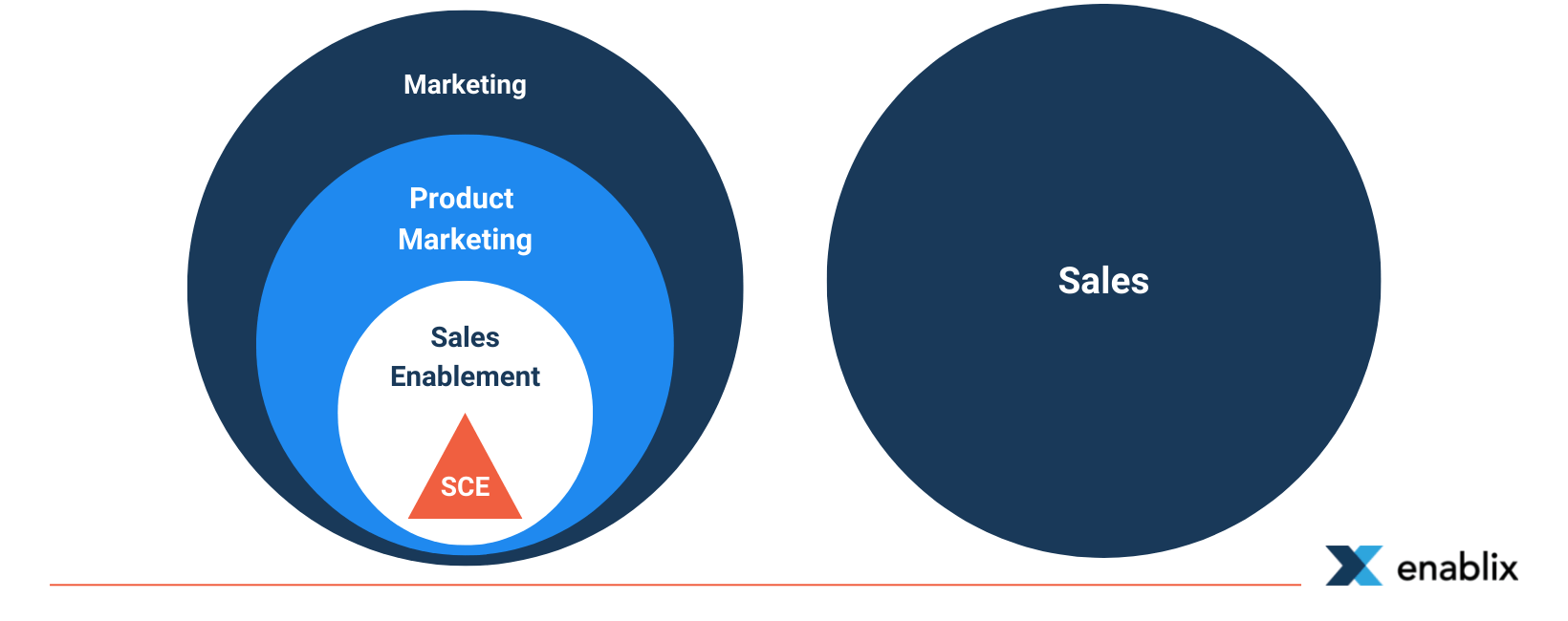Why Marketing Should Own Sales Content Enablement


Originally published 8/13/2020, updated 11/1/2022 to reflect more recent industry trends
Sales reps are important, but what if we told you that your content is what actually makes or breaks a buying decision?
According to Gartner, customers spend roughlytwo-thirds of any B2B buying journey interacting with whatever content they can find, which means the content they see holds a lot of power.
We refer to this process as Sales Content Enablement, an important piece of the Sales Enablement function. Sales content enablement helps provide sellers with the resources they need to inform and sell to buyers.
However, there is a debate on who should own the Sales Content Enablement process and function within an organization. Given that the function is called “sales content enablement” and is an important piece of Sales Enablement, you might assume that’s who it belongs to. However, there are some arguments for why that might not be the best structure.
In this post, we’ll explain why Marketing is a better owner for the sales content enablement function, plus how Sales Enablement fits into the content enablement equation.
Read the summary below, or click here to download the full guide!
Download The Guide
Why Marketing Is Suited to Own Sales Content Enablement
Marketing Owns Messaging
The Marketing team (including Product Marketing) owns this messaging function in an organization. This team is responsible for defining messaging and positioning and asking relevant questions such as:
- Who are your buyers?
- Who is the Ideal Customer Profile (ICP)?
- What markets should we target?
- How do we differentiate from our competitors?
These are important factors that feed into the messaging strategy and these details also form the foundation for the enablement content. Every piece of contentmust align with the company’s messaging and positioning , and the entire organization needs to be on the same page about it. If the messaging foundation is not solid, you risk having content and conversations that aren’t relevant to the buyers and will miss the mark.
As the owner of messaging, Marketing is also in charge of making sure all content is consistent, which is why they are best suited to own sales content enablement too.
Marketing Owns Branding
Like messaging, company branding is owned by Marketing and has a direct impact on the content.
Branding is not just colors, fonts, logos, and styling. It is a strategy designed by organizations that helps prospects quickly identify and experience the brand. That experience should help prospects understand what the brand is , and give them a reason to choose a product over the competition. Other teams, like your sales reps, aren't going to have the same attention to detail when it comes to branding, which is why this function is owned by Marketing.
Given branding’s impact on content, Marketing is the only team that can monitor content in order to make sure every experience with branding is consistent.
Marketing Contributes Majority Of The Content
Today, organizations need to enable sales teams with a variety of content types and information. Reps need customer-facing and internal-facing content, from various areas of the company, to support buyers through the purchasing process. This means that more teams need to be involved in the content creation process, in order to ensure that content is covering all areas.
The Sales Enablement Collective’s 2022 Landscape Report, shows that less than a quarter of all content created for sales, actually comes from Marketing.

While this is an interesting statistic, if we include Product Marketing content (which would come from a division of the Marketing team), as well as the influence Marketing has to ensure that branding and messaging are consistent– the Marketing teams are actually still the largest contributors of content in a typical organization. Since Marketing owns branding and messaging, even the enablement and “other” content will go through Marketing to ensure quality and alignment.
So, although Marketing doesn’t directly make 100% of the content, they are involved in the creation of it all– also making them the best team to own the Sales Content Enablement process.
Marketing Is Better Aligned With Other Revenue Teams
Content Enablement is no longer limited to Marketing and Sales teams. Customer Success and Product teams are driving more and more revenue for an organization– and therefore, the content enablement process should include them too, as well as any other teams that impact revenue.
Based on where Marketing sits in an organization, the team is better aligned with these additional revenue-impacting teams than the Sales Enablement team, making them the best owner of this collaborative function.
Today’s Buyers Demand Consistent Experience
The majority of your customers start their buying journey somewhere that’s owned by Marketing:
-
* Website- Events/Trade Shows
- Webinars
- Social Media
And then they progress into something owned by sales:
-
* Discovery Meetings- Product Demos
- Presentations
- Proposals
- Negotiations
- Contracts
A successful content enablement initiative needs to serve this entire process, so it doesn’t make sense to have Marketing own the enablement process half-way through the buyer’s journey and then pass the baton to the Sales Enablement team for the other half. This change in ownership is bound to introduce inconsistencies and confusion for your buyers and could negatively impact your sales results.
In order to not hurt your buyer’s experience, Sales Enablement content would need to come first, under the Marketing owned portion of the buyer journey.
Where Does Sales Enablement Fit In?
Organization structures can look different across different companies, making this a little more confusing. We’ve laid out 3 common structures and how Marketing can own Sales Enablement content within these organizations:
1. Product Marketing Owns Sales Enablement

This structure makes things easier, because everyone is on the same team. Marketing, Product Marketing and Sales Enablement are all working together to create sales content enablement. Sales can easily request content through Slack or a project management tool like Trello or Jira. The entire Marketing function works together to create trainings, content and anything else the sales team needs.
2. Sales Owns Sales Enablement

If the Sales Enablement team sits under the sales function, more communication is required to make this structure work.
Marketing should elect a lead that would be responsible for communication about sales and customer service teams’ content needs. Project management tools should also be used here to manage timeline expectations, as Marketing can only create so much content at once.
Additionally, regular meetings between Sales Enablement and Marketing can be used to review content needs, give feedback on current content and discuss timeline expectations. Sales and sales content enablement should also meet at a regular cadence in order to discuss content trends, feedback and the best usage of existing content.
3. There is no enablement team

While this is a rare structure, it still exists across organizations and will also work if good communication is in place. If a team has a powerful revenue operations team, a Sales Enablement team might not be needed. In this case, an informal space like Slack or Teams, can be used to record content needs. In this structure it is still important to designate a marketing lead for creating sales content– without this person, requests can fall through the cracks and content won’t be as effective.
Let’s be honest - the process of finding the best structure for you and your company may not be easy, and could change around as the company evolves. The most important thing is to keep trying to find the right mix for you and your teams, understanding it will likely change over time.
And if we can get cheeky for a moment, the simplest way to define the dynamics of Marketing and Sales Enablement teams in the context of the sales content enablement process is:
“Marketing owns the ingredients and sales enablement owns the recipes.”
Download The Full Guide Now
